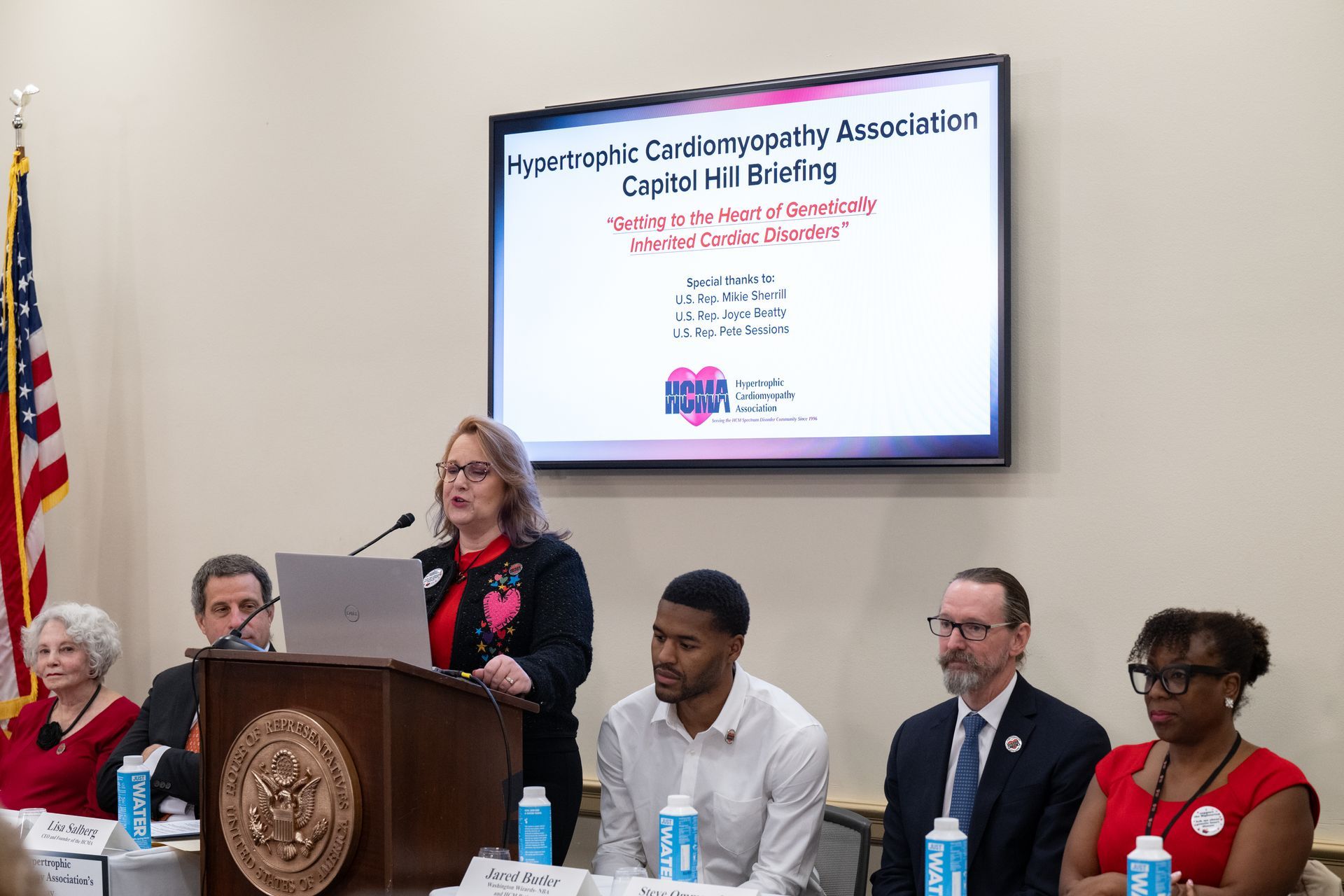Fabry Disease
A missing enzyme has health consequences
What is Fabry Disease?
Fabry Disease is rare. There are classic and late-onset forms. About half of Fabry Disease patients have heart involvement. Late-onset Fabry includes "HCM appearance" in half of male patients and a third of female patients. Fabry affects body parts including the kidneys, brain, gut, lungs, eyes, ears, and nerves.

Fabry Disease is a genetic condition that can run in families, like HCM. It can look like HCM because the heart is one of the organs that may be affected. Effects on the heart include Left Ventricular Hypertrophy (LVH), like HCM.
What Causes Fabry Disease?
Fabry Disease (FD) is caused by the lack of an enzyme (called α-galactosidase A or α-Gal A). This enzyme breaks down a fatty substance that can cause organ damage if it builds up in the body. Because α-Gal A is missing or the body produces only a little of it, those with FD need enzyme replacement therapy to avoid organ damage.
Classic and Late-onset Fabry
The classic type of Fabry Disease begins in early childhood, and symptoms can be severe. The first symptom in children as young as 2 is often pain in the hands and feet. A later-onset type of FD occurs in those who produce some α-Gal A, and this type is often limited to heart issues.
Genetics and Sex Differences in Fabry Disease
FD is caused by a mutation of the GLA gene. This gene tells the body to make α-Gal A. This gene is linked to the X chromosome. Fabry is usually more severe in people with XY chromosomes (typically male). People with XX chromosomes (typically female) have a range of symptoms because they have two chances to have one normal X chromosome. Genetic testing is important for all sexes as part of the diagnosis of FD. In XY patients with the classic type, α-Gal A activity will be very low, which is a reliable way to diagnose FD. While rare, it is possible for XX patients to have a severe case. Many XX patients have no or mild symptoms.
Delayed Diagnosis
The diagnosis of FD is often delayed. Starting enzyme therapy later means that organ damage has already begun. Treatment may not work as well if it starts too late. In later-onset FD, a diagnosis comes when symptoms begin, or the condition gets worse.
How is Fabry like HCM?
Fabry Disease can look like HCM because its effect on the heart includes left ventricular hypertrophy (LVH). There may also be fibrosis (scarring of the heart muscle). Problems with electrical conduction, arrhythmias, and heart failure are common. It's important to use imaging and blood tests to see how much the heart is affected. Over 50% of those with Fabry eventually have heart problems.
Later-onset FD may be mistaken for HCM. LVH in males with classic Fabry shows up on average around age 30. In females with classic Fabry, LVH is more likely to appear around age 50. For those with later-onset Fabry, the average age to develop LVH is around 55, for both males and females. About 50% of males and 33% of females develop LVH.
How is Fabry diagnosed and monitored?
ECG/EKG
Arrhythmia, bradycardia, and other abnormal heart rhythms may help show the difference between FD and other causes of LVH. Some FD patients can be identified with EKG before hypertrophy begins.
Mobile EKG Technology
Smartwatches and other mobile devices may help find problems with heart rhythm and high or low heart rate. Some patients will have an implanted loop recorder to monitor them for abnormal heart rhythms.
MRI/CMR
Cardiac MRI (CMR) should be done when FD is diagnosed in any patient over 25. It should also be done if arrhythmia is found in patients under 25. If the first CMR is normal, this test should be repeated every 5 years. If a patient on enzyme replacement therapy has heart symptoms, CMR should be done every 2-3 years. If the LVH is severe, CMR should be done every year.
Echocardiogram
An echocardiogram should be done when FD is first diagnosed. This test should be repeated every year in those over 18 and every 2-3 years in those under 18. It is used to watch for cardiomyopathy and complications such as valve issues. CMR is better for measuring LVH. Both CMR and echo should be used to monitor FD heart changes.
Early heart changes in female patients with FD but without LVH may be hard to see on echo. Early changes are best detected with CMR and blood tests.
Laboratory Tests
Two blood tests, troponin, and NT-proBNP, are important for tracking heart changes. NT-proBNP levels may be high without LVH, so this is a helpful test to find heart involvement early. Both of these tests can also detect kidney failure.
Genetic Testing and Family Screening
When a person is diagnosed with FD, genetic testing is offered to family members to find others who have it. Family members with late-onset type can be treated earlier if this screening is done.
Testing beyond the heart
FD may damage organs other than the heart. Especially in males, these include the kidneys, blood vessels, brain, stomach, bowels, lungs, ears, eyes, and nerves.
It is important to monitor FD patients for kidney failure. They may also have atrial fibrillation (AFIB), unusual bleeding, and low gut mobility. Many have hearing and eye problems.
A stroke or TIA (mini-stroke) can be the first sign of the disease, so doctors should think of FD when a patient has a stroke before age 50. The risk of stroke is much higher in patients with AFIB or kidney disease.
Brain MRI helps find problems in the brain. It is recommended at diagnosis in male patients over 20 and female patients over 30. Brain MRI should be repeated at least every 3-5 years or when changes are seen that could lead to stroke.
Gastrointestinal (GI) symptoms, such as abdominal pain, bloating, and diarrhea, may be early signs of FD. These symptoms can be misdiagnosed as common conditions such as irritable bowel disease.
Family Planning
Men with Fabry pass on their genetic mutation to all female children only. Male children get a normal X chromosome from the mother (assuming she doesn't have Fabry). The Y chromosome is from the father, and Fabry is linked to the X. Female children get the normal X from their mother. They get an abnormal X from their affected father.
Women with Fabry pass on their genetic mutation to half of their children, both males and females. IVF may be helpful for women with Fabry to screen out embryos with the disease mutation.
A genetic counselor can help you navigate your options around having children.
Symptoms of Fabry
Sudden deafness, eye problems, breathing issues, pain, and fatigue are symptoms that FD patients may have. These symptoms impact quality of life, so it's important to watch for them and manage them.
Symptoms such as severe nerve pain, kidney disease, HCM, chest pain, arrhythmias, and stroke can happen over time. This is especially true for classic, early-onset, FD patients.
In later-onset FD, the disease is usually milder, with the heart as the main organ involved. Heart problems in this type of FD can be severe. Chest pain is often caused by microvascular disease. These patients are the most likely to be misdiagnosed with HCM. This is one reason genetic testing is so important for those diagnosed with HCM.
Treatment
Because FD can involve many organs and cause many symptoms, treatment must be based on the patient's needs.
Fabry Disease is chronic. It can be treated but not cured. FD patients need a team of specialists in the different organs that are affected. Therapy should be integrated, and the team must communicate with one another. Therapy must be tailored depending on symptoms and organ involvement.
Enzyme Replacement Therapy
Since 2001, enzyme replacement therapy (ERT) has been used to stabilize, delay, or prevent organ damage. ERT also improves symptoms. There are several versions of this ERT, and which is available depends on the country you live in. An additional therapy, migalastat, may be added for some patients with FD. ERT works best if started before the age of 40, but the earlier, the better.
ERT may cause the body to make antibodies if it is seen as a foreign substance. The antibodies may attack the ERT, making it less effective. Blood tests must be done to check antibody levels before the first infusion. Blood tests are repeated every 3-6 months during the first 18 months of treatment. Then, every 6-12 months until there are two negative results in a row.
The earlier FD is diagnosed, the better the treatment will work. If treatment is started before organ damage gets bad, it can prevent some symptoms and damage. If ERT is delayed too long, kidney damage will be hard to reverse, and the outcome is usually poor.
Vaccines and Masks
FD patients should use vaccines and masks to avoid getting sick from colds, flu, and illnesses. The risk of death from COVID-19 or flu is higher in patients with kidney disease, those on dialysis, and transplant recipients. If an FD patient has lung problems, this can increase the danger from any virus that affects the lungs.
Citations:
An expert consensus on practical clinical recommendations and guidance for patients with classic Fabry disease. Molecular Genetics and Metabolism 2022, Oct, 137 (1-2), p 49-61.
Cardiac MRI in Fabry disease.
Front Cardiovasc Med. 2023, Feb, 2;9:1075639.

 Translate
Translate